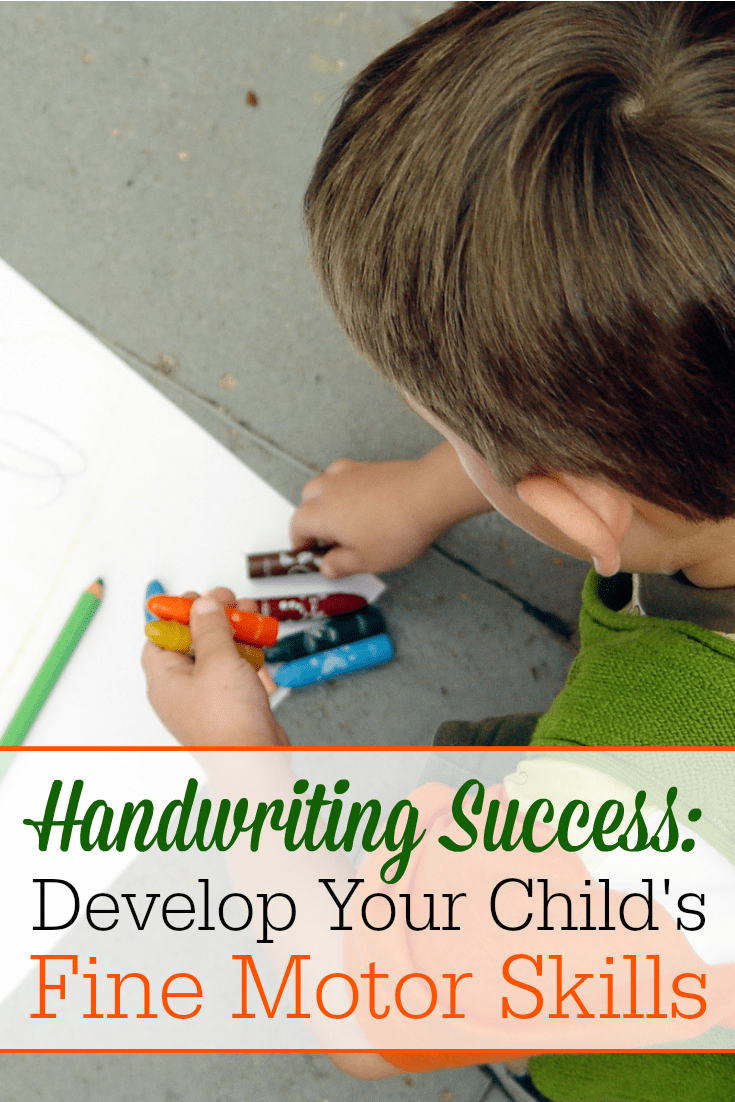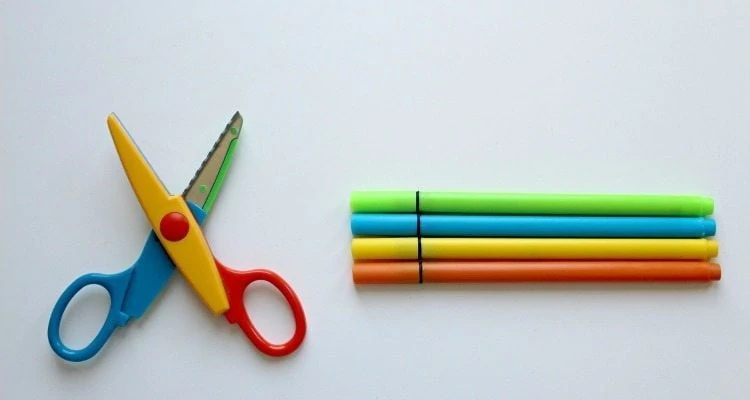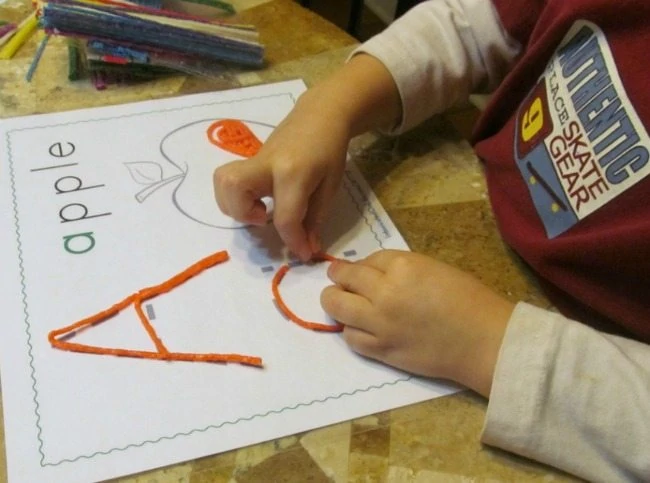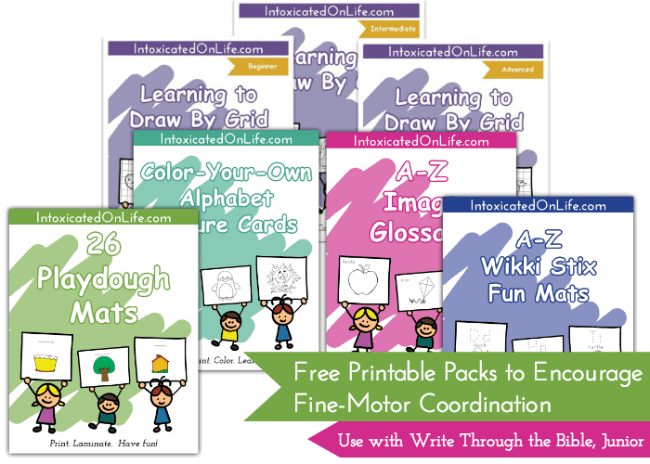Want to teach your preschooler or Kindergartner fine motor skills that will build their handwriting? Here are some GREAT ideas and resources!

Guest post by Trisha of Intoxicated on Life
How can you help your preschooler or Kindergartner get better at handwriting? Over the years, I’ve had to learn this the hard way.
My oldest son has pretty terrible handwriting. He obviously doesn’t enjoy writing, either—unless he’s creating a treasure map or writing a contract that he’s trying to trick his younger brothers into signing. You can tell when he’s getting bored writing out assignments for school, too. He starts to write like his pen is Zorro’s sword, which ends up looking like he’s writing something in Japanese, not English.
We chalk a lot of his poor handwriting up to not developing fine motor skills earlier in childhood. When he was a little boy, he was more interested in running around or playing with cars than he was drawing, painting, or coloring. The contrast between him and our heavily artistic second-born child is like night and day.
What are “fine motor skills”?
Motor skills are task-performing muscle movements that need to be learned over time with practice. There are gross motor skills and fine motor skills.
- Gross motor skills use big muscle groups: doing things like crawling, sitting up straight, standing up, walking, or using the stairs.
- Fine motor skills use smaller muscle groups to do more precise tasks: using a fork or spoon, cutting paper with scissors, tying shoes, buttoning a shirt, or turning the page of a book.
Are fine motor skills that important?
Studies show developing good fine motor skills in preschool and kindergarten are actually a predictor of academic success throughout elementary school and even into middle school.
- Some think it has something to do with the areas of your brain that get a workout when you practice fine motor skills.
- Some think it also has to do with ease of learning handwriting: if you are stronger at handwriting, then you are freeing up mental space and energy to focus on what you’re writing, not how you’re writing.
Science now shows us (by hooking kids up to MRI equipment) that young people who practice their handwriting skills actually increase their critical thinking and verbalization skills. Handwriting has also been shown to increase a child’s “visual memory”—and poor visual memory is one of the reasons why students have difficulty reading.
How do you build up fine motor skills?
You can build up your child’s fine motor skills by engaging them in what’s called “fine motor play.” Give them fun activities that require them to use their hands in new ways, giving them stronger dexterity in their hands. This can include…
- Playing with playdough
- Drawing, tracing, and painting
- Cutting and gluing
- Playing with Wikki Stix on plastic mats
- Stacking blocks, linking blocks, and connector sets
- Putting together puzzles
- Putting toothpicks into berries or other finger foods
- Sorting beads, pebbles, buttons, or other small objects
- Stringing beads or macaroni noodles onto string
- Picking something up with clothespins
- Putting together nuts and bolts
- DIY dinosaur or car kits
- Lacing boards or cards
- Playing with squirt guns
- Peeling and placing stickers
If you’d like a complete list of ideas, go to intoxicatedonlife.com/21ways. You’ll get explanations and more than 100 pages of FREE printables to help you teach fine motor skills!
Teaching handwriting and God’s word at the same time
I told you about my oldest son’s poor handwriting. A few years ago I developed a handwriting curriculum that would not only help him become better at handwriting (which he did), but would also reinforce the lengthy passage of the Bible we were learning as a family. Eventually I put it online for others to use, and this has spawned a whole line of products called Write Through the Bible.
Over the last couple years I’ve heard from many moms who wanted me to create something for their young kids who are just learning their letters. I’m excited to announce that our very first workbook for 4 to 6-year-olds is now out! You can teach your kids letter formation and new vocabulary, and further develop their fine motor skills—all while focusing on God’s word. Check out Write Through the Bible, Junior!
Note from Erin: I have seen a copy of this in person at my friend’s house, and it looks fantastic! I plan on ordering a copy for my girls!! Here are some other preschool and kindergartner resources I’m investing in.
Handwriting might seem daunting at first–to you and your little one!–but make it fun and stick with it!

How do you help to develop your child’s fine motor skills?
Trisha Gilkerson is wife to her best buddy Luke and homeschooling mama to 4 boys. She and her husband blog together at Intoxicated on Life about raising a healthy family – body, mind, and soul. Stop by to subscribe and download all of their free resources for families!







Tracy
In the picture of the child tracing an “A,” what is he writing with? We need to work on proper grip. My 3-year-old daughter loves to trace and write, but insists on holding the crayon/marker/pen/whatever with a fist. She’ll hold it properly when I help her and while I’m watching, but quickly goes back to the fist grip. I’ve tried getting her to use broken crayons but she’s definitely not a fan.
Tracy
Ahhh, never mind, I see that it’s yarn in the pic. Looks fun and we’ll try it 🙂 Sill open to suggestions though!
Sara
I believe it is wikki stiks – those wax covered pieces of string.
Jean | DelightfulRepast.com
I’m so glad to see someone teaching their children handwriting. I saw in the news about a year ago that many schools across the country were eliminating handwriting from the curriculum. That’s just crazy!
Sarah
Thanks for the great ideas! That book looks pretty fantastic.
-Sarah
Lizzy
I was wondering what the difference was between fine and gross motor skills and this has explained so well, and why we need to pay attention. My 4 year old is very artistic and loves all the above mentioned things but this encourages me to do it more often, and also why we need to focus on handwriting.
Erin
I’m so glad you were encouraged!